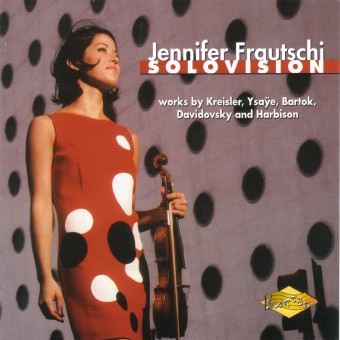ARTEK Recordings
Reviews of CD 16

Click to Order Recording

ARTEK Recordings
|
 |
![]()
ARTEK RECORDINGS CD16: Jennifer Frautschi -
violin Solovision
Fanfare
"Jennifer Frautschi possesses a large and powerful tone and a well-developed technique. In these regards, she's like many other young aspirants to violinistic eminence. But a keen rhythmic sense and quick reflexes that sharpen rapid attacks complement a fine sense of color and a stylistic penetration that set her apart. The Recitativo of Kreisler's Recitativo and Scherzo-Caprice sounds more like delicate Ysaÿe than Kreisler; the Scherzo, although still not quite Kreisler, isn't anyone else either. Frautschi clarifies the stylistic connections with both violinists, following chromatic meandering in the Recitativo with piquant verve in the Scherzo. Kreisler's rhythmic springiness served as a hallmark of his playing; and, since he never recorded this work, it's intriguing to imagine how he performed it (or how Ysaÿe did). Frautschi's version, more than most I have heard, calls the composer's playing to mind. Her exploration of the subtler, more elusive work that Ysaÿe dedicated to Kreisler shares some of this rhythmic spring, and sets ruminative phrases in strong contrast with more virtuosic flourishes, which abound in these works.
"As aggressive as Frautschi may sound at times, she doesn't simply slash and burn. The first movement of Bartók's Solo Sonata, and even more, the jagged Fuga that follows, sometimes serve as a pretext for violinists to hack and thrust with the glee of children playing insouciantly with knives. Frautschi's reading of both movements, and of the spectral Presto as well, takes a more introspective tack, though displaying vivid color and extroverted special effects (as in the fugue's pizzicatos).
"Mario Davidovsky's Synchronisms isn't a solo piece in the strictest sense, setting the violin as it does in the context of prerecorded sounds. The composer's note, included in the booklet, cites his intention of unifying the instrumental and the electronic in a coherent whole. The electronic sounds bounce back and forth across the soundstage, and the violin matches their seeming capriciousness with highly virtuosic leaping figuration. I'm not sure whether the composer would tolerate such a response, but the chase sounds like a jolly one (and lots of fun for the violinist), with plenty of local color along the way.
"According to his note, John Harbison wrote his Four Songs of Solitude for his wife, who gave them their first performance almost two decades ago. They're more lyrical than pyrotechnical and, although harmonically diffuse, suggest loose organization around tonal centers and, especially in the third and fourth, familiarity with idiomatic violin technique. Frautschi treats them reflectively, as she did Bartók's Sonata, emphasizing their haunting plaintiveness.
"In this recital, Frautschi plays the 1722 ex-Cadiz Stadivari, with
which she mixes a varied
palette of timbres. Solo recitals and solo-recital recordings have
become more common, but not programs
evincing this combination of aplomb and stylistic sensitivity. Strongly
recommended for these
qualities, as well as for the program's inherent interest -- which
might ingratiate it even with
conservative listeners."
- Robert Maxham
![]()